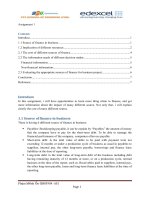1644 assignment 1 (pass)
Bạn đang xem bản rút gọn của tài liệu. Xem và tải ngay bản đầy đủ của tài liệu tại đây (1.07 MB, 35 trang )
ASSIGNMENT 1 FRONT SHEET
Qualification
BTEC Level 5 HND Diploma in Computing
Unit number and title
Unit 16: Cloud computing
Submission date
Date Received 1st submission
Re-submission Date
Date Received 2nd submission
Student Name
DAO VINH KHANG
Student ID
GCS200222
Class
GCS0905B
Assessor name
VANHH
Student declaration
I certify that the assignment submission is entirely my work and I fully understand the consequences of plagiarism. I understand that
making a false declaration is a form of malpractice.
Student’s signature
Khang
Grading grid
P1
P2
P3
P4
M1
M2
D1
2
CONTENTS
Contents
CONTENTS ....................................................................................................................................................... 6
CONTENTS Figure ............................................................................................. Error! Bookmark not defined.
I. ANALYZE THE EVOLUTION AND FUNDAMENTAL CONCEPTS OF CLOUD COMPUTING (P1) ....................... 9
1. Introduction to the history ...................................................................................................................... 9
Figure 1: THE EVOLUTION OF CLOUD COMPUTING ........................................................................................ 9
2. Fundamental concepts of cloud computing (Exin, 2022)...................................................................... 11
3. The need of cloud computing (Patra, 2022).......................................................................................... 12
II. DESIGN AN APPROPRIATE ARCHITECTURAL CLOUD COMPUTING FRAMEWORK FOR A GIVEN SCENARIO
(P2) ......................................................................................................................................................................... 13
1. Cloud computing architecture............................................................................................................... 13
Figure 2: CLOUD COMPUTING ARCHITECTURE ............................................................................................. 13
2. Architecture design for ATN organization ............................................................................................. 14
Figure 3: ARCHITECTURE DESIGN FOR ATN COMPANY ................................................................................. 14
3. Dependencies and components of ATN application ............................................................................. 15
Figure 4: COMPONENTS OF ATN COMPANY TO BUILD CLOUD ..................................................................... 15
III. DISCUSS WHY AN ORGANIZATION SHOULD MIGRATE TO A CLOUD COMPUTING SOLUTION (M1) ...... 16
1. Advantages and disadvantages of using Cloud computing solution (Peterson, 2022) ......................... 16
2. Persuade organizations to use Cloud computing instead of local applications .................................... 18
Figure 5: CLOUD IMPACT ON BUSINESS ........................................................................................................ 18
Figure 6: RESPONDENTS ARE USING CLOUD ................................................................................................. 19
P3. Define an appropriate deployment model for a given scenario. ............................................................ 21
I.
Four deployment model:..................................................................................................................... 21
II.
Deployment model for ATN Company: ........................................................................................... 22
V. COMPARE THE SERVICE MODELS FOR CHOOSING AN ADEQUATE MODEL FOR A GIVEN SCENARIO (P4)
................................................................................................................................................................................ 23
1. Service models (IBM, 2022) ................................................................................................................... 23
Figure 11: CLOUD SERVICE MODELS .............................................................................................................. 23
Figure 12: IaaS, PaaS, SaaS.................................................................................................................... 24
Figure 13: INFRASTRUCTURE AS A SERVICE................................................................................................... 25
....................................................................................................................................................................... 26
Figure 14: PLATFORM AS A SERVICE.............................................................................................................. 26
Figure 15: SOFTWARE AS A SERVICE ......................................................................................................... 28
2. Service model for ATN application: PaaS .............................................................................................. 29
VI. DEMONSTRATE THESE DEPLOYMENT MODELS WITH REAL WORLD EXAMPLES (M2) ........................... 30
1. Public Cloud ........................................................................................................................................... 30
Figure 16: PUBLIC CLOUD PROVIDERS ........................................................................................................... 31
2. Private Cloud ......................................................................................................................................... 31
Figure 17: PRIVATE CLOUD EXAMPLE ............................................................................................................ 32
3. Hybrid Cloud .......................................................................................................................................... 32
Figure 18: CISCO AND GOOGLE HYBRID CLOUD ............................................................................................ 33
4. Community Cloud .................................................................................................................................. 33
Figure 19: SALESFORCE COMMUNITY CLOUD ............................................................................................... 34
VII. REFERENCES ........................................................................................................................................... 34
I. ANALYZE THE EVOLUTION AND FUNDAMENTAL CONCEPTS
OF CLOUD COMPUTING (P1)
1. Introduction to the history
Figure 1: THE EVOLUTION OF CLOUD COMPUTING
i.
The Late 1990s (Foote, 2022)
The cloud was initially used to represent the empty space between the end user and the supplier.
Emory University Professor Ramnath Chellapa characterized cloud computing in 1997 as "a new computer
model in which the boundaries of computation will be dictated by economic logic rather than
technological restrictions." This relatively hefty explanation applies to cloud evolution.
As organizations develop a greater knowledge of the cloud's offerings and utility, it has grown in
favor. Salesforce became a well-known example of a successful usage of cloud computing in 1999. They
utilized it to pioneer the concept of delivering software packages to end customers through the Internet.
Anyone with access to the Internet may see and download the software (or application). Businesses may
get on-demand, low-cost software without leaving the office.
ii.
The Early 2000s (Foote, 2022)
Amazon launched its web-based commerce services in 2002. It was the first large company to regard
using barely 10% of their capacity (which was usual at the time) as a problem to be solved. They were
able to use their computer's capability significantly more efficiently because to the cloud computing
architecture Model. Soon after, other significant corporations followed suit.
Amazon We Services, which provides online services to other websites or clients, was started in
2006. Amazon Mechanical Turk, one of Amazon We Services' sites, offers a variety of cloud-based services
such as storage computing and "human intelligence."
The Google Docs service was introduced the same year. Google Docs was built on the foundations
of two different products, Google Spreadsheets and Writely. Google should develop Writely, which allows
renters to store documents, update them, and upload them to a tracking system.
IBM was founded in 1947. Google and many institutions collaborated to create a server farm for
research projects that required both fast processors and large data collections. The University of
Washington was the first to sign up for and use IBM and Google resources. Carnegie Mellon University,
MIT, Stanford University, the University of Maryland, and the University of California, Berkeley was fast
to follow suit.
iii.
2010 and beyond (Foote, 2022)
Although private clouds were introduced in 2008, they are still in the early stages of development and
are not widely used. Concerns regarding the insecurity of public clouds are a powerful motivator for the
usage of private clouds. By 2010, firms such as Amazon Web Services, Microsoft, and OpenStack had
created fully working private clouds.
In 2011, the notion of hybrid clouds was established. A certain level of interoperability is required between
a private and public cloud, as well as the ability to move workloads back and forth between the two clouds. At
the time, relatively few businesses had systems capable of doing so, despite the fact that many desired to
because of the tools and storage that public clouds could provide.
IBM created the IBM SmartCloud architecture in 2011 to assist Smarter Planet. Then Apple introduced
iCloud, which focuses on keeping more personal information.
Oracle Cloud was announced in 2012, offering three platforms for businesses: IaaS, PaaS, and SAAS.
These "basics" are gradually becoming the norm, with some public clouds offering all these services while
others only one. SaaS has grown in popularity.
Multi-cloud began when businesses began to use SaaS providers for services such as human
resources, customer relationship management, and supply chain management. It began to gain
popularity around 2013-2014.
Cloud computing had evolved fundamental functionality by 2014, and security had become a key
worry. Given the significance of cloud security to clients, it has become a quickly expanding service. Cloud
security has advanced dramatically in recent years, and it now provides protection on par with traditional
IT security solutions.
The cloud began to change from developer-friendly to developer-driven in 2016. Application
developers began to take full use of the cloud's offered capabilities. Many services attempt to be
developer-friendly in order to attract more clients.
2. Fundamental concepts of cloud computing (Exin, 2022)
i.
Cloud Computing
That is merely a fancy way of saying a network, and in most cases, it refers to the Internet. Cloud
computing refers to storing or accessing information or applications in the Cloud: either at a privately
owned Internet site or on a third-party server placed in a data center.
ii.
The Building Blocks of Cloud Computing
Cloud computing vendors provide their services in various models, which are commonly referred to
as tiers. Infrastructure as a Service (IaaS), Platform as a Service (PaaS), and Software as a Service are the
three standard models (SaaS).
iii. The Role of IT in Cloud Computing
The job of IT personnel is changing as cloud computing advances. Computer scientists' new responsibilities
are that of facilitators and brokers.
iv.
Benefits
Cloud computing enables businesses to avoid or reduce fixed IT infrastructure expenditures.
Furthermore, third-party clouds enable enterprises to concentrate on their core competencies. Other
benefits of cloud computing that have been mentioned include flexibility and scalability. v. Risks
You should be aware of various legal and practical considerations.
Governance
vi.
Cloud Computing impacts policies relating to using services.
vii.
Competencies
IT personnel will need to be trained for the cloud age. Some staff could require further training.
3. The need of cloud computing (Patra, 2022)
•
One of the primary reasons why a significant number of small- and large-scale company sectors
from all over the world are utilizing cloud computing nowadays is the great influence on cost
savings. Yes, cloud computing has drastically reduced the cost of hardware and software, as well
as other server resources.
•
Instead of using physical gear and software, we may operate all our workload data of apps and
processes online over the internet remotely.
•
Day-to-day operations such as server maintenance, software/hardware installation, and license
renewal are all handled by cloud computing service providers.
•
We may use the cloud to access whatever data or apps we want, whenever and whenever we want,
via the internet. Installing and updating 100 preset programs is possible.
•
The cloud not only handles data storage remotely, but it also protects and recovers all crashed or
lost data, so we don't have to worry about crashed or lost data, and it provides excellent security.
II. DESIGN AN APPROPRIATE ARCHITECTURAL CLOUD
COMPUTING FRAMEWORK FOR A GIVEN SCENARIO (P2)
1. Cloud computing architecture
DEFINITION: Cloud architecture refers to a collection of components meant to use the power of
cloud resources to address business challenges in the form of databases, software capabilities, apps, and
so on. Components and their interactions are defined by cloud architecture.
Figure 2: CLOUD COMPUTING ARCHITECTURE
FRONT-END ARCHITECTURE: The phrase "front-end architecture" refers to any aspect of the cloud
computing architecture that is visible to the user. It is the component with which the end user interacts, and it
is composed of sub-components that provide the user experience. The front-end architecture, which typically
takes the shape of a user interface, is critical to how people interact with cloud applications. Most IT workers
today will deal with cloud software architecture largely through the user interface. Web browsers, local area
networks, and standard web applications are all part of the front-end architecture.
BACK-END ARCHITECTURE: The back-end architecture of cloud computing is the component of the
architecture that powers the front-end architecture. This contains the system's essential components,
including as hardware and storage, and is often located in a server farm at a geographically remote
location. The cloud service provider that provides cloud software is in charge of the back-end
architecture. Popular cloud providers, such as AWS, often have robust backend infrastructure to assure
ongoing low latency uptime. On top of that, sophisticated frontend cloud architecture contributes to the
creation of a solution that is both dependable and simple to use.
2. Architecture design for ATN organization
Figure 3: ARCHITECTURE DESIGN FOR ATN COMPANY
EXPLAINATION FOR THE ARCHITECTURE DESIGN:
•
We develop cloud architecture based on the ATN scenario to solve the company's present
difficulties.
•
First, the shop manager has their own interface to edit, insert, and delete data from each day,
which is subsequently sent to a private cloud to be stored.
•
A third-party firm deploys and maintains the private cloud.
•
In addition to the private cloud, we have another server at the head of the firm that backups all of
the data from the private cloud.
•
The Boss and the maintenance staff each have their own interface for updating the summary delete
monitoring database and systems.
3. Dependencies and components of ATN application
COMPONENTS OF ATN APPLICATION
Figure 4: COMPONENTS OF ATN COMPANY TO BUILD CLOUD
•
The ATN firm model's cloud is built using ASP.net technology, and the database is built with MySQL
server.
•
Then we run the dev and finish the website requests on the local host.
•
Following that, we utilize PaaS Heroku to deploy our Internet site to the we then deliver it to users.
III. DISCUSS WHY AN ORGANIZATION SHOULD MIGRATE TO A
CLOUD COMPUTING SOLUTION (M1)
1. Advantages and disadvantages of using Cloud computing solution (Peterson, 2022)
ADVANTAGES:
•
Cost Savings: One of the most significant advantages of cloud computing is cost savings. It allows
you to save a significant amount of money because it does not require any actual hardware
investments. In addition, no trained personnel are required to maintain the hardware. The cloud
service provider purchases and manages the equipment.
•
Strategic edge: Cloud computing provides you with a competitive advantage over your
competition. It is one of the finest benefits of Cloud services since it allows you to access the most
recent programs at any time without having to spend time and money on installation.
•
High Speed: Because of the speedier deployment, you may receive the resources you need for your
system in less minutes.
•
Back-up and restore data: When data is kept on the cloud, it is easier to do backup and recovery,
which is normally a time-consuming procedure on-premises.
•
Automatic Software Integration: You don't need to put in extra effort to personalize and integrate
your programs to your liking.
•
Reliability: One of the most significant advantages of Cloud hosting is its dependability. You can
always stay up to date on the latest developments.
•
Mobility: Employees that work on-site or in remote locations have easy access to all available
services. All they require is Internet access.
•
Unlimited storage capacity: The cloud offers practically endless storage space. You may rapidly
increase your storage space at any moment for extremely low monthly prices.
•
Collaboration: The cloud computing platform enables employees from many locales to interact in
a more comfortable and safe manner.
•
Quick Deployment: When you choose to use the cloud, your complete system may be up and
running in a matter of minutes. However, the length of time required depends on the technology
employed in your firm.
DISADVANTAGES:
•
Performance Can Vary: When you operate in a cloud environment, your application runs on a
server that also delivers resources to other enterprises.
•
Technical Issues: Cloud computing is prone to outages and other technological difficulties. Even
the top cloud service provider firms, despite maintaining strong maintenance standards, may
encounter this sort of problem.
•
Security Threat in the Cloud: Before implementing cloud technology, you should be aware that you
will be entrusting all of your company's sensitive data to a third-party cloud computing service
provider.
•
Downtime: Your cloud provider may experience power outages, poor internet access, service
maintenance, and other issues.
•
Internet Connectivity: You cannot access the cloud unless you have an internet connection.
Furthermore, there is no alternative means to collect data from the cloud.
•
Lower Bandwidth: If your company exceeds the allotted budget, the additional expenses might be
prohibitively expensive.
•
Lacks Support
2. Persuade organizations to use Cloud computing instead of local applications
Figure 5: CLOUD IMPACT ON BUSINESS
Figure 6: RESPONDENTS ARE USING CLOUD
•
Maintain a business focus: ATN recognizes that operating an IT department is not their main
expertise; they would be better off as attorneys, surgeons, or plumbers. Purchase cloud services
as a single application, such as Salesforce. Customers' success platforms for ATN or their whole
data center are frequently more cost efficient, more dependable, and allow them to reallocate
their scarce resources to Business Development.
•
Business agility: ATN that have made considerable technological investments may find themselves
unable to profit on market developments or adapt to competition challenges due to a lack of cash,
personnel, or time. in the steps required to respond Cloud services eliminate these restrictions,
allowing businesses to constantly change their technology needs to meet the demands of their
enterprises without incurring the expenditures associated with on-site data centers.
•
Reduce capital costs: Large capital investments can be reduced or completely removed in favor
of small monthly payments. Capital can be safeguarded since minimizing capital and operational
expenditures is crucial for small and medium-sized firms. Scale: Businesses with varying peak
seasons or seasonal employment requirements might profit from cloud services by temporarily
increasing capacity for seasonal business peaks without acquiring hardware or software that will
not be needed during slower times of the year.
•
Accessible from any location: One of the primary advantages of cloud services is the ability to do
business without the need of B Border. Authorized users can access your apps and data from
anywhere there is Internet connectivity.
•
Human resource efficiency: Cloud services can assist you in maintaining an efficient technology
team by outsourcing essential technical majors or technology professionals as your business
requires.
LO2 Evaluate the deployment models, service models and technological drivers of Cloud Computing and
validate their use
P3. Define an appropriate deployment model for a given
scenario.
I.
Four deployment model:
The model has four deployments:
• Private Cloud.
• Hybrid Cloud.
• Public Cloud.
• Community Cloud.
Compare four cloud Deployment Models:
Public
Private
Community
Hybrid
Ease of use and
setup
Easy
Requires IT
proficiency
Requires IT
proficiency
Requires IT
proficiency
Privacy and
security of data
Low
High
Comparatively
high
High
Control of data
Little to none
High
Comparatively
high
Comparatively
high
Reliability
Vulnerable
High
Comparatively
high
High
Flexibility and
scalability
High
High
Fixed capacity
High
Cost-intensive,
the most
expensive one
Cost is shared
among community
members
Cheaper than a
private model but
Costeffectiveness The cheapest one
more costly than a
public one
Demand for
hardware made
in-house
II.
No
Depends
Depends
Depends
Deployment model for ATN Company:
Despite the fact that ATN is a large company with a high-productivity product chain, the
company's stability, cost savings, ability to Great scalability, and flexibility make it an ideal
solution to the issue raised in the article.Rapid Deployment The Public Cloud can be deployed
in a matter of hours.A public cloud can be an option because it is managed by an external
provider like Amazon Web Services or the Cloud Server of Viettel IDC in Vietnam, which is used
by millions of people every day.appropriate for ATN.However, due to the fact that data is
frequently stored in a single location, it is technically less secure than Private Cloud or
Colocation.However, the public cloud is significantly safer when the appropriate information
security measures are in place.
V. COMPARE THE SERVICE MODELS FOR CHOOSING AN
ADEQUATE MODEL FOR A GIVEN SCENARIO (P4)
1. Service models (IBM, 2022)
The three most popular forms of cloud service delivery are IaaS PaaS and SaaS. (They are also known
as cloud service models or cloud computing service models). IaaS, PaaS, and SaaS do not have to be
mutually exclusive. Many mid-sized organizations employ many, and the majority of big enterprises use
all three.
Figure 11: CLOUD SERVICE MODELS
The term “as a service” refers to how computing assets are used in these services as well as the key
difference between cloud computing and conventional computing. Traditional IT uses computer
hardware system software development tools and applications by purchasing installing administering and
maintaining them in its own on-premises data center. Cloud service providers that own manage and
maintain cloud computing assets; consumers use them through an Internet connection and pay for them
y subscription or y pay-as-you-go.
Figure 12: IaaS, PaaS, SaaS
i.
IaaS (Infrastructure as a Service)
IaaS is on-demand access to cloud-hosted computing infrastructure (servers storage and network
resources) that customers can build configure and use. the same way they use on-premises hardware.
The cloud service provider on the other hand hosts operates and maintains the hardware and computer
resources in its own data centers. IaaS users access the hardware over an internet connection and pay
for it via a subscription or pay-as-you-go model.
Figure 13: INFRASTRUCTURE AS A SERVICE
BENEFITS OF IaaS:
Compared to traditional computing IaaS allows customers to build up computing resources as
needed and scale them up or down in response to traffic spikes or slowdowns. Customers can avoid the
upfront costs and costs of purchasing and operating their own on-premises data centers y using IaaS. It
also avoids the perennial trade-off between the waste of having additional capacity in place to
accommodate spikes and the poor performance or crashes that can result from insufficient capacity to
support the surge. spikes or unexpected traffic.
•
Increased Availability: With IaaS a business can quickly set up multiple servers even in other
regions to maintain availability during local outages or natural disasters.
•
Lower latency means better performance. IaaS customers can ring applications and services
closer to consumers to reduce latency and optimize performance as IaaS providers often
operate data centers in other countries. together.
•
Increased responsiveness. Customers can provision resources in minutes quickly test new
ideas and quickly deploy new ideas to others.





